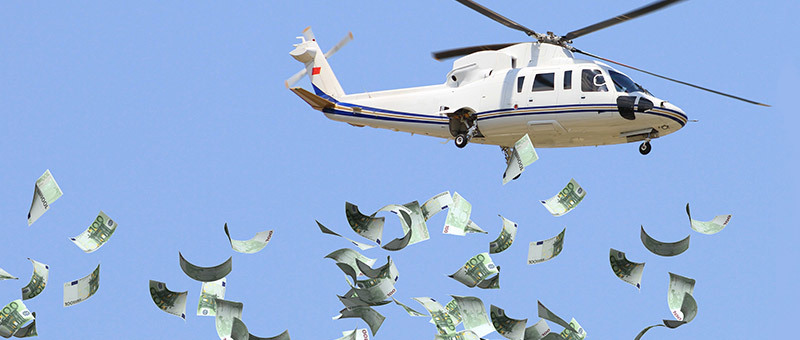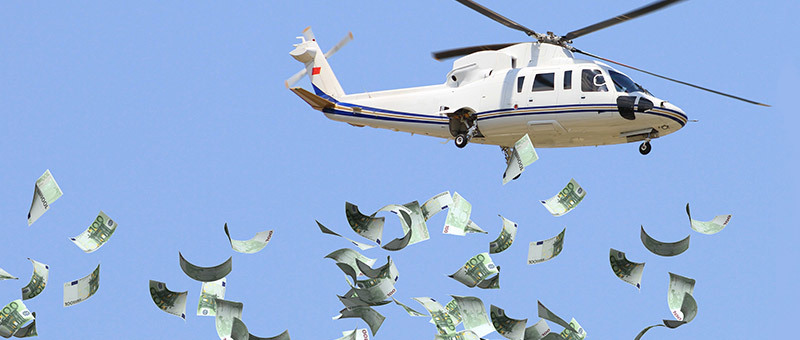
If a helicopter flew overhead dropping bank notes
would you pick them up and spend them?
What if the government sent you a check for $500, no questions asked?
Although that may sound too good to be true it’s an idea that’s being taken seriously right now
as a way to keep economies moving as the impact of the coronavirus pandemic is felt across the world.
So how does this helicopter money work?
As people stay at home and businesses shutter , governments and central banks around the world are considering extreme measures to support their economies through the coronavirus crisis.
The consumption of goods and services, or consumer spending, is one of the key drivers of the economy.
Consumer spending accounts for 58% of the world’s gross domestic product or GDP.
And in countries like the U.S. and U.K., it’s even more representing a whopping two-thirds of their GDPs.
So, if consumer spending slows down, or stops, the economy runs into big trouble. Governments around the world are urging their citizens to stay home, as they attempt to contain the spread of the virus.
And while these measures will hopefully save lives, economies are already seeing business closures and job layoffs as a result. The number of Americans filing for unemployment, for example, skyrocketed to unprecedented levels in March. Those claims then doubled just a week later.Without a steady stream of income coming in, many people are understandably anxious about parting with their money
meaning consumer spending will take a big hit.
One proposed solution is for governments to make payments to every person.The argument is that if you have extra money in your bank account, you’ll feel less worried about the future and be more inclined to spend.
So why might this be more effective than other steps being taken by central bankers and lawmakers?
As fears about the pandemic escalated, central banks acted fast by slashing interest rates and lending money to keep businesses afloat. But just because it’s cheaper to borrow money, it doesn’t mean that people will want to take out loans, especially when they are nervous about the future.
Meanwhile, legislators have proposed cutting payroll taxes and reducing tax rates And while these measures may help business owners and salaried employees, gig workers and the unemployed will not feel the benefits. That’s where the simplicity of handing out a sum of money to everyone comes in
The argument is that reaching a wider number of people will encourage consumer spending.
And this is where we get the image of a helicopter dropping bundles of cash down on a crowd.
One way to finance this “helicopter drop” would be for a country’s central bank to print more money.
Another way would be for governments to borrow money, adding to their national debt.
Methods that have been proposed to distribute the dough include mailing out pre-paid cards,
or simply showing ID at a bank to claim their cash. Some governments are beginning to give it a go.
The Hong Kong government, which has a history of cash handouts,
announced in February plans to give permanent residents HK$10,000 or US$1,280.
It’s hoping the extra spending money will help mitigate the economic double whammy
of months of protests followed by the pandemic.
In March, U.S. policymakers approved a coronavirus stimulus package which sends out $1,200 to every adult earning below a certain level. Other countries around the world are also considering similar schemes.
However, the idea of direct cash handouts certainly isn’t new. The term ‘helicopter drop’ itself was coined by economist Milton Friedman in 1969 as a thought experiment, rather than as a practical policy tool. But the suggestion that relatively small increases in the money supply will feed demand goes back much further to economist John Maynard Keynes who was searching for ways to revive the economy after the Great Depression.
One real-life example is Japan, which doled out $6 billion worth of “shopping coupons”
to 31 million people during a brutal recession in 1999. The program, which required recipients to use the coupons locally within six months, is viewed as a moderate success in the country with the government even rolling out a similar program ten years later.
So why would anyone be against the idea of free money?
There are some practical roadblocks. For example, many governments don’t have a full database of each and every one of their citizens. There’s also the fear that once people get the taste for it, they’ll keep asking for more. In the long term, that could lead to runaway inflation though this may be less of a concern these days with inflation rates at historically low levels. There’s also the theory that if people know their taxes may rise in the future to pay for a helicopter drop, they’ll simply save the money to meet this future obligation. But supporters of the idea say this doesn’t necessarily reflect the decisions would people make in the real world when faced with immediate needs.
During the Great Recession in 2008, the U.S. government sent out $100 billion in tax rebates,
called economic stimulus payments to 130 million taxpayers.Unfortunately, the money wasn’t able to stop the recession from taking hold, and one survey found only 20 percent of the people who received the checks actually spent them. Another objection to a helicopter drop scheme is that it’s not a long-term solution. It doesn’t help workers keep their jobs or find new ones if they’re unemployed,
and a one-time cash payment certainly doesn’t go as far as a steady paycheck.
This suggests governments should focus instead on helping businesses keep employees on their payrolls. But even this option still leaves many people in the economy, like self-employed workers or contractors, behind. Another problem which may be the biggest, is political. It would be a momentous decision to create these large sums of money. Doling out cash to the general population goes far beyond the job description of unelected central bankers. In many countries such a move would be illegal.
Central banks and governments would also have to work together to create and distribute the helicopter money. But if governments simply directed central banks to print the money, this would challenge the idea that they should make decisions independently.In the Euro zone, this coordination could be particularly tricky because of the divide between the European Central Bank, which looks after monetary policy, and the various national governments which retain control over taxation and expenditure.
In a worst-case scenario, these measures could ultimately result in the loss of trust in central banks and the currencies they print, which some argue could undermine our financial system completely. For the helicopter drop to stimulate spending, the public must believe it to be “a unique event which will never be repeated”, as described by Friedman in his thought experiment. Although dishing out cash to the general public might sound like a desperate measure, it’s also a powerful weapon of last resort for governments and central banks seeking to combat falling consumer demand. As dark clouds form on the horizon, don’t be surprised if you hear those choppers heading your way.

